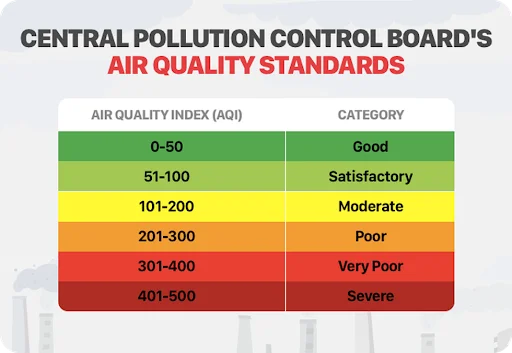Introduction
- Delhi’s air pollution crisis has once again captured attention as the Air Quality Index (AQI) in several areas, including Alipur, Anand Vihar, Bawana, Narela, Pusa, and Sonia Vihar, has hit the hazardous 500 mark.
- This choking smog has forced the implementation of the Graded Response Action Plan (GRAP) in the Delhi-NCR region, highlighting the urgent need for sustained and effective interventions.
What Is Air Pollution and How Is It Measured in India?
- Understanding Air Pollution: Air pollution refers to the contamination of the atmosphere by harmful chemicals, particulates, or biological materials. These pollutants adversely affect human health, degrade the environment, and cause significant economic losses.
- Measuring Air Pollution in India: The National Air Quality Index (NAQI), introduced by the Central Pollution Control Board (CPCB) in 2014, is the primary tool used to monitor air quality in India. It evaluates eight key pollutants:
- Particulate Matter (PM10 and PM2.5)
- Nitrogen Dioxide (NO2)
- Sulphur Dioxide (SO2)
- Carbon Monoxide (CO)
- Ozone (O3)
- Ammonia (NH3)
- Lead (Pb)
- The NAQI categorizes air quality into six levels ranging from “Good” to “Severe,” making it easier for policymakers and citizens to assess pollution trends.

What Causes Delhi’s Air Pollution?
- Stubble Burning: Farmers in Punjab, Haryana, and Rajasthan burn crop residue after harvest, releasing pollutants like methane (CH4), carbon monoxide (CO), and carcinogenic hydrocarbons. According to the IIT Consortium Report, stubble burning contributes up to 35% of Delhi’s PM2.5 levels during October-November.
- Winter Weather Patterns: Low wind speeds and Delhi’s landlocked location prevent the dispersion of pollutants. Falling temperatures lower the inversion height, trapping pollutants close to the ground.
- Vehicular Emissions: Delhi has a high density of private vehicles, contributing to 40% of particulate matter emissions.
- Construction and Waste Burning: Unchecked construction activities and the burning of landfill waste significantly increase pollution levels.
- Firecrackers: Diwali celebrations exacerbate pollution as firecrackers emit toxic substances.
- Urban Development: Rapid expansion of grey infrastructure and shrinking green cover worsen the ecological balance.
- Industrial Activities: Insufficient regulation of industrial emissions adds to Delhi’s pollution woes.
- Dust from Neighboring Regions: Seasonal northwesterly winds carry dust from Pakistan, Afghanistan, and the Gulf region into Delhi.
Read also: High-Performance Buildings | UPSC
The Harmful Impacts of Air Pollution
- Economic Consequences
- India loses approximately $95 billion annually (3% of GDP) due to air pollution, as estimated by the Confederation of Indian Industry.
- Rice and Wheat: Studies have shown a 10–40% reduction in rice and wheat yields in northern India due to ozone exposure.
- Health Hazards
- Polluted air causes respiratory infections, cardiovascular diseases, and lung cancer.
- The Global Burden of Disease (2015) attributed 1.8 million premature deaths in India to air pollution, alongside a loss of 49 million disability-adjusted life years (DALYs).
- Cardiovascular Issues: Prolonged exposure to polluted air increases the risk of ischemic heart disease and hypertension. According to the Lancet Commission, air pollution contributed to 2.3% of cardiovascular deaths in India in 2021.
- Cancer Risks: Carcinogenic substances in polluted air, such as polycyclic aromatic hydrocarbons (PAHs) from vehicle emissions, increase lung cancer risks, particularly among urban residents.
- Neurological Effects: Studies indicate that long-term air pollution exposure leads to cognitive decline and a higher incidence of Alzheimer’s disease in elderly populations.
- Environmental Effects
- Acid Rain: Damages crops, soil, and monuments like the Taj Mahal. Acidifies lakes and rivers, reducing fish populations. The Loktak Lake in Manipur has experienced ecosystem stress due to such acidification.
- Eutrophication: Excess nitrogen in water bodies leads to algal blooms, disrupting aquatic ecosystems. Examples include algal blooms in the Chilika Lake, which disrupt local fisheries. Marine dead zones, such as those seen in the Bay of Bengal, are exacerbated by eutrophication.
- Global Warming: Pollutants like black carbon and methane contribute to rising global temperatures, accelerating glacier melt in the Himalayas.
Government Interventions to Address Air Pollution
- Crop Residue Management Scheme (CRM): Subsidies are provided to farmers for purchasing eco-friendly equipment such as Turbo Happy Seeders, Super SMS attachments, rotavators, and superseeders to discourage stubble burning.
- Commission for Air Quality Management (CAQM): Established under the CAQM Act, 2021, this statutory body oversees and coordinates efforts to combat air pollution in the Delhi-NCR region, with a focus on mitigating stubble burning and industrial emissions.
- Initiatives to Reduce Vehicular Pollution:
- BS-VI Fuel Norms: Transition from BS-IV to BS-VI emission standards.
- Electric Vehicle (EV) Policy: Delhi’s EV Policy 2020 aims for 25% of all new vehicle registrations to be electric by 2024. Incentives like purchase subsidies, scrappage benefits, and subsidies for charging infrastructure have been introduced.
- Odd-Even Scheme: A traffic rationing strategy implemented during high-pollution periods to reduce vehicular emissions.
- Graded Response Action Plan (GRAP): GRAP imposes measures like banning construction activities, shutting thermal power plants, and limiting industrial activity during severe pollution episodes.
- Real-Time Air Quality Monitoring: Installation of continuous ambient air quality monitoring stations (CAAQMS) to provide real-time pollution data and enable immediate interventions.
- Anti-Dust Campaign: The Delhi government enforces strict dust control measures, including mandating anti-smog guns and water sprinkling at construction sites, and imposing fines for non-compliance.
- Tree Plantation Drives: Massive afforestation campaigns like the Green Delhi Initiative aim to increase the city’s green cover. In 2023, the Delhi government pledged to plant over 1 crore saplings across the National Capital Region.
- Ban on Single-Use Plastics: A strict prohibition on the use of single-use plastics to reduce waste generation and burning.
- Closure of Badarpur Thermal Power Plant: The coal-fired Badarpur plant, one of Delhi’s major pollution sources, was permanently shut down in 2018.
- Delhi Electric Vehicle (EV) Charging Network: Installation of over 500 public EV charging stations to encourage the use of electric vehicles.
- Water Sprinkling and Anti-Smog Towers: Deployment of water sprinklers and installation of anti-smog towers at high-pollution zones to directly reduce particulate matter in the air.
- Waste-to-Energy Plants: The Delhi government is promoting waste-to-energy initiatives, where municipal waste is processed to generate power, reducing landfill burning. One prominent example of a waste-to-energy initiative in Delhi is the Okhla Waste-to-Energy Plant, operated by Timarpur-Okhla Municipal Solid Waste Management Company Pvt. Ltd. This plant processes approximately 2,000 tons of municipal solid waste daily, generating around 16 MW of electricity, which is supplied to the grid.
- School Awareness Programs: Initiatives like the “Green Schools Campaign” aim to educate students about the importance of air quality and involve them in environmental conservation activities.
- Red Light On, Gaadi Off Campaign: A behavioral initiative encouraging drivers to switch off their vehicle engines at traffic signals to reduce idling emissions.
Read this: India-Nigeria Relations: Key Insights for UPSC Exam
Way Forward
- Increase Monitoring Stations: Deploy more AQI monitoring units and introduce sensor-based systems for hyperlocal data. Delhi has installed 40 Continuous Ambient Air Quality Monitoring Stations (CAAQMS), providing real-time AQI data. However, cities like Los Angeles utilize hyperlocal sensor networks for granular pollution tracking, which Delhi can replicate by deploying low-cost sensors for high-pollution zones.
- Empower Local Bodies: Equip urban authorities with resources and powers for targeted actions against violators. The Delhi Pollution Control Committee (DPCC) has been granted powers to impose fines on construction sites violating dust control norms.
- Sustainable Infrastructure: Expand green spaces and prioritize afforestation to enhance air quality.
- Waste Management: Implement effective systems for managing construction debris and landfill emissions.
- Cloud Seeding: Explore this method for temporary relief during severe AQI levels. Though still under consideration in India, China has used cloud seeding extensively during events like the 2008 Beijing Olympics to reduce pollution and improve air quality temporarily. Delhi can explore similar initiatives during peak AQI periods.
- Circular Economy Models: Develop markets for crop residue and industrial byproducts. Delhi has initiated programs to create compressed bio-gas from stubble under the National Bio-Energy Mission.
- Learnings from Global Practices:
-
- London: The Congestion Charge Zone restricts private vehicles in central London, reducing traffic and emissions by nearly 15% since its introduction.
- Beijing: The city caps new car registrations through a lottery system, limiting annual sales and reducing vehicle density.
- Singapore and Hong Kong: Hong Kong’s Octopus Card integrates all modes of public transport, encouraging residents to use the system instead of private vehicles.
- Farmer Incentives: Promote alternatives to stubble burning by creating viable markets for crop residue. Punjab and Haryana have adopted the Pusa Bio-Decomposer, a microbial solution developed by the Indian Agricultural Research Institute (IARI), to convert stubble into compost.
- Industrial Accountability: Mandate industries to report pollutant emissions and mitigation efforts under SEBI’s Business Responsibility and Sustainability Reporting (BRSR) framework.

